The relation of electroacoustic music to the visual domain is based on an inherent paradox. All electroacoustically reproduced sound, whether speech, music, environmental sound, or synthesized timbres are by definition "disembodied" from their unseen source. This schizophonic condition (Truax, 2001), as originally described by R. Murray Schafer, tends to become banalized in its everyday acceptance, unless its presence in an environment is thought to be overly intrusive (e.g. a cellphone ringing in a quiet space). In fact, the embedding of one soundscape within another, has become so commonplace that it is sometimes termed an "accompaniment medium" because it is designed to be just that, an unseen presence that overlays an everyday acoustic environment.
The changes brought about via electroacoustics are not merely in the soundscape, but perhaps mainly in the effects on listening habits. Listeners become accustomed to interpreting, even relying on music, radio, media presentations and so on, as a "natural" presence in the environment, even if they are not "of" the environment, i.e. sources that are physically present. Any cognitive dissonance largely disappears, unless the reproduced sound is unfamiliar, somehow threatening, or particularly offensive. In fact, it is possible to trace the life cycle of such sounds from the phobic reactions that often greet them when first experienced, through to an habituated acceptance, and finally to their status as a "disappearing sound" that may eventually become a nostalgic sound romance.
Given the evolution of the electroacoustic soundscape and listener over the course of the 20th century, it is somewhat puzzling why electroacoustic music (which I will define simply as music created and distributed via audio technology, regardless of aesthetic style) has not received greater acceptance. Perhaps it is the transition from "the new" to "the familiar" that is somewhat slower than with other related phenomena.
Within the electroacoustic community, this absence of the visual has in fact been celebrated with the term "acousmatic", even if it is a word that is unfamiliar to the general public. The term is sometimes explained as the absence of the physical source of an electroacoustic sound (with the famous reference to Pythagorean teaching practice), but I prefer the interpretation that the sound is sufficient in itself and does not require a visual presence. This concept seems to resonate with what we know of aural cultures where sound was regarded as having its own power and sufficiency.
Yet, even within the electroacoustic music world, are we truly free of the visual influence? We speak of sound shapes or spectromorphology (Smalley) and sound images (Wishart). Timbre is often described in visual or tactile terms, and perhaps most subtly, we often refer to "acoustic space" more by reference to visual space than to the somewhat more elusive aural experience of that space. One could argue that such references to shapes, images and spaces need not be understood as visually tinged, but in practice I think they often are. However, contemporary neuropsychology in its study of brain behaviour provides evidence that all of the perceptive centres are inter-related, and even though purely auditory phenomena can be localized to the auditory cortex, connections are always being made to other centres.
II. Soundscape Composition
A particularly interesting instance of the relation of the auditory to the visual in terms of music arises with the genre of the soundscape composition. As distinct from more abstract or even abstracted electroacoustic music, soundscape composition (Truax, 2002) inherently refers to actual sonic environments and the listener's experience of them. Inevitably, some listeners will react to a soundscape work by conjuring up a visual image of the imagined space, as well as particular experiences they have had that relate to that space. Interestingly, most soundscape compositions avoid adding a visual component, such as video, presumably to encourage the listener to concentrate on the sound (often assuming the listener tends to take sound for granted in everyday life). Or perhaps, as I would prefer to think of it, the absence of the visual is preferable because, as the old story goes about why radio is preferable to television, the answer is that the "pictures" are better!
However, there is a well known trend towards "multi-media" production, and inevitably many composers and artists prefer an audio-visual production and cite its appeal to a broader public. On a personal level, I tend to think that I am not particularly visually inclined when it comes to music, and that my compositional approach is mainly based in aural experience. On the other hand, I come from a family with a century-long love affair with photography, and I have never been too far from having a camera in my hand. In thinking about the role that the visual domain has played in my work, I can think of three aspects:
- a visual image has occasionally been an inspiration for a work- I have produced music for several collaborations with the visual artist/composer Theo Goldberg, as well as for a video by Thecla Schiphorst
- I have produced a video version of one of my works, Androgyne, Mon Amour
III. Visual Inspiration
Just as I have occasionally found inspiration from poetry or the insights and imagery of the I Ching, there have also been instances where a visual image helped to focus my imagination on the structure of a particular work. For instance, I was struck by the aerial photograph of the South Pacific island of Moorea by Sylvain Grandadam:

This photograph seemed to capture the image of an "ideal" island, a self-contained world capable of mystery, enchantment, or in fact whatever one wanted to project onto it. Although I did not try to reproduce any particular aspect of this island, its image influenced my work Island (2000), which proposed (as described in the program notes) "a visit to an imaginary island imbued with magical realism, beginning at the shoreline, proceeding up a rapidly flowing stream, visiting a resonant cistern, climbing to the windy peak of a mountain lake, descending again through a nighttime forest of crickets, and ending at a different shoreline."
A recent work, called The Shaman Ascending (2004-05), was inspired by a pair of Inuit sculptures from Labrador known by the same name:
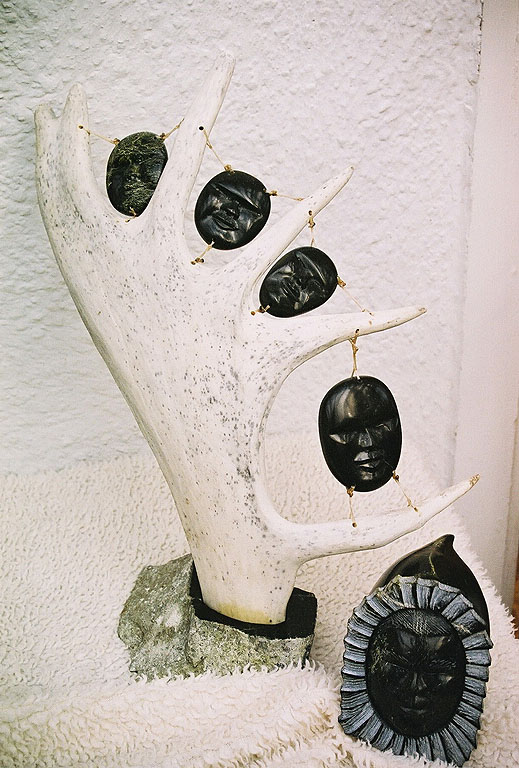
The aural inspiration for the work was Inuit throat singing, a rhythmic type of chanting characterized by rough timbres. I imitated this type of vocalization by using granulation techniques to extract short phonemes from a bass singer's voice (Derrick Christian), repeat them rhythmically and spatialize them with the rapid spinning (up to 10 times a second) of 8-16 simultaneous voices around an octophonic space. In trying to come to terms with this complex material, I found inspiration in these recently acquired sculptures. The shaman face is echoed as it ascends up the branches of the antler, with the version at the top gleaming radiantly. I interpreted this ascendancy as an attempt to represent the quest for spiritual ecstasy via chanting. In my work, the image of "ascending" is achieved by bringing out the upper harmonics in the voice each time the chanting sequence climaxes. The five faces of the sculpture are reflected in the five sections of the piece.
IV. Mixed Media
I have collaborated with composer and visual artist Theo Goldberg on several mixed media works over the years:
Beauty and the Beast (1989), for Narrator (oboe d'amore & English horn), computer images, and two digital soundtracks (23')Divan (1985), for computer graphic slides and two digital soundtracks (11')
Night of the Conjurer (1992), video tape with optional cello (11')
Pacific Dragon (1991), for computer graphic slides and four digital soundtracks (14')
Song of Songs (1992), for oboe d'amore, English horn, two digital soundtracks and computer graphic images (19')
The Wings of Nike (1987), for computer graphic slides and two digital soundtracks (16')
In addition, I have used some of his images on the covers of my CD's, such as Pacific Rim, the image for which was taken from The Wings of Nike.
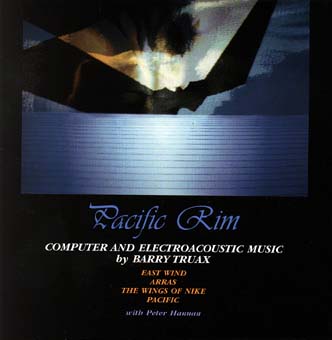
Since Theo Goldberg was familiar with both the visual arts and music, and had thought a great deal about their possible correlation (Goldberg & Schrack, 1986), his advice to me when we started collaborating was to treat the two elements as independent, yet derived from a common idea. I took this to mean that direct correlation was unnecessary, and that each medium should develop according to its own logic, but be informed by a common idea that was central to the work. The balance between freedom for each medium, but coherence between them, always seemed to work in each collaboration we undertook.
V. Visual Interpretation
Inspired by the success of these collaborative efforts, I turned to the video medium where I designed both the visual and aural tracks. The first attempts were short videos designed to be used in conjunction with my opera Powers of Two. However, a more ambitious project presented itself in 2001, namely to create a stand-alone video version of my work based on
the lyrical homoerotic poetry of Tennessee Williams found in his anthology Androgyne, Mon Amour (1977), my work taking the same title. As described earlier (Truax, 2000), the first version of the work is a music theatre piece, written for the American virtuoso double bass player, Robert Black, whose recorded performance appears on the Twin Souls CD. The poems, as read by Douglas Huffman, are heard on tape, and in the performance an illusion is created that they are addressed to the instrument itself as the "androgyne" character of the text. To support this illusion the text is often processed through resonators that model a physical string and are tuned to the pitches of the open strings on the bass.
In my video version of the work a male dancer, Walter Kubanek, acts out the androgyne character. At several key points in the video the image of the dancer is superimposed on that of the bass as played by Robert Black. In the opening sequence "You and I" the illusion is intensified by seeing the body of the nearly nude dancer, head down, feet in the position of the instrument's neck, being stroked and bowed by the bassist. The image cuts to a closeup of the dancer's body being struck by a real bow during the col legno gestures. In the subsequent solo dance sequence, the dancer appears twinned (through superimposition of a digitally reversed image) with a mirror image of himself.
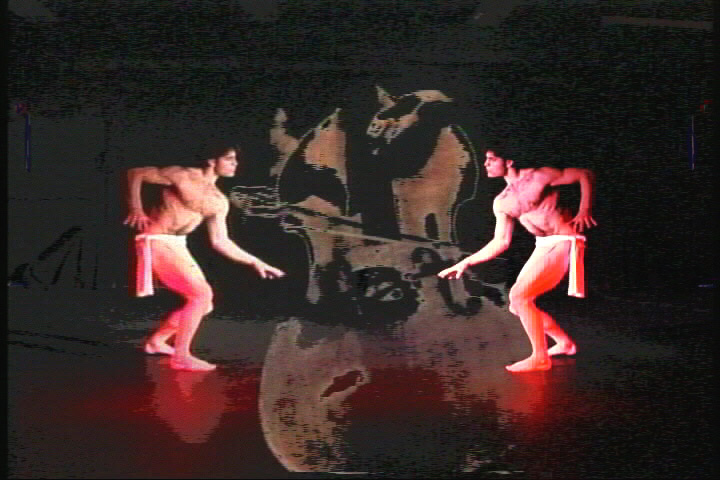
The erotic peak of the work, entitled "Liturgy of Roses", shows the dancer first asleep and then waking, superimposed over the seated bassist playing harmonic glissandi, and then in a duet with the bass instrument itself against a background of a closeup of the instrument covered in roses. The dancer moves sensually around the instrument exploring its curves and apertures, the cadence of this sequence cutting to a closeup of the dancer asleep in an embrace of the instrument.
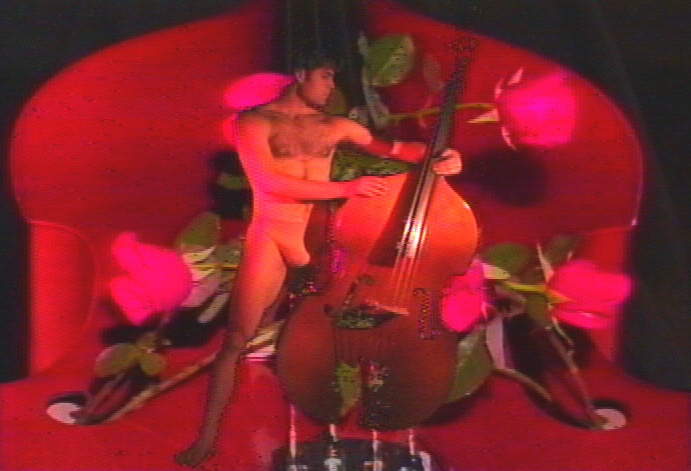
The next scene, "Wolf's Hour" depicts the aftermath of the erotic encounter, when it's 3 am and the lover has left. The bassist is smoking a cigarette, then looks longingly at the instrument lying on the ground and moves to caress it, at which point an image of the sleeping dancer is superimposed. The twinned version of this image appears on the CD cover.

In the video version, two versions of the dancer are superimposed, one sleeping, the other which gets up from the prone position and begins to exit across the screen, pausing at two points while the mournful musical line ascends through the entire compass of the instrument.
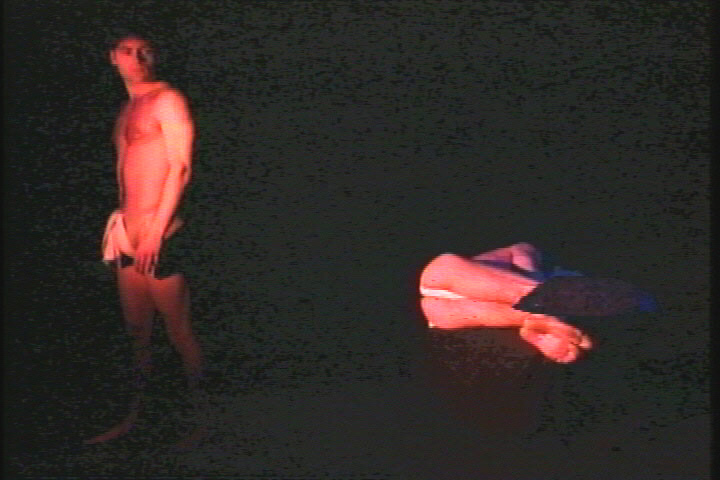
The next poem, "The Ice-Blue Wind", is treated as a dream, and refers to a musician playing a single tune on top of a roof in winter. The dancer now appears as an ethereal figure representing the wind of the title.

In the final section, when the piece returns to the second half of the "You and I" poem, the mirror sequence is repeated, this time with a 7 second delay. This amount of de-synchronization creates the illusion of a second character rather than a mirror image, in keeping with the text "Who am I? … An enemy of yours. Your lover."
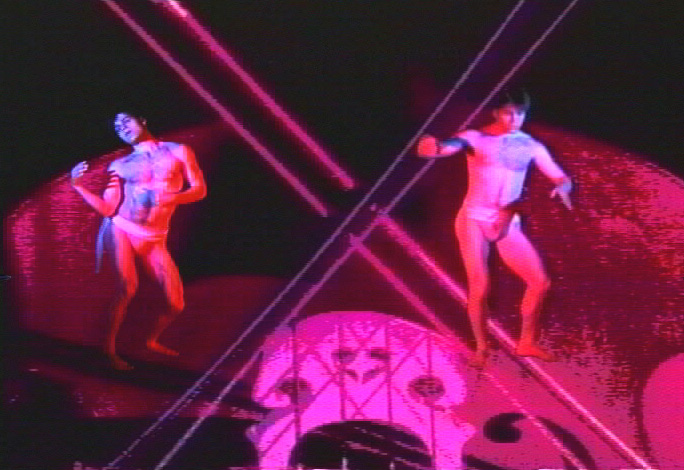
The video makes the homoeroticism of the text and the music much more explicit, but ultimately it is a visualization of the drama played out in the live performance version where the "desired other" must be imagined by the listener (Truax, 2003). In the most recent performance of the work (June, 2004, Toronto), the live version with the double bass was combined with a modified version of the video showing only the sequences with the dancer. I will leave it up to the listeners to determine whether the pictures were better.
References:
Goldberg, T. & Schrack, G. 1986. Computer-aided correlation of musical and visual structures, Leonardo, vol. 19, no. 1, pp. 11-17.
Truax, B. 2000. The aesthetics of computer music: A questionable concept reconsidered. Organised Sound, 5(3), 119-126.
Truax, B. 2001. Acoustic communication, 2nd ed., Ablex Publishing.
Truax, B. 2002. Genres and techniques of soundscape composition as developed at Simon Fraser University, Organised Sound, 7(1), 5-14.
Truax, B. 2003. Homoeroticism and Electroacoustic Music: Absence and Personal Voice, Organised Sound, 8(1), 117-124.
Williams, T. 1977. Androgyne, Mon Amour. New York: New Directions Press.